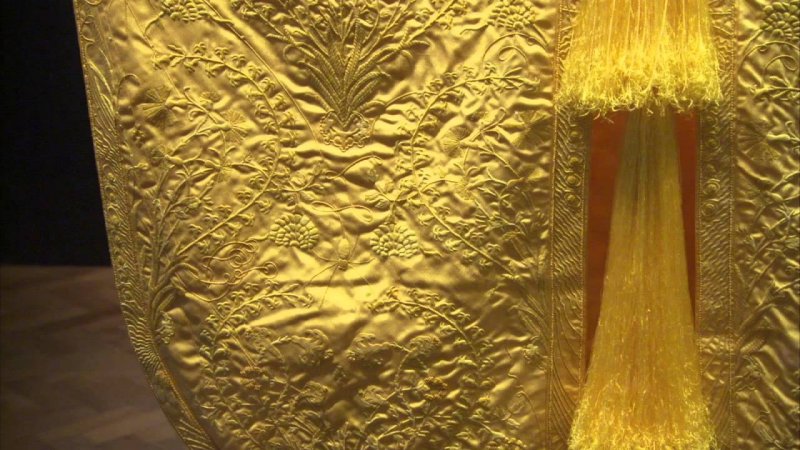Jan Bartek – AncientPages.com – This unique golden silk textile is so magnificent you would like to buy it, but it is no ordinary cloth available in the shops. The minor workers behind this marvelous creation were as many as 1.2 million spiders!
This is the largest piece of golden spider silk cloth in the world, and it goes without saying it is one of the rarest silk textiles you can come across.

A cape made from Madagascar Golden Orb spider silk exhibited at London’s Victoria and Albert Museum. Credit: Cmglee – Public Domain
Producing the golden silk cloth was time-demanding. It took 80 especially skilled workers three years and thousands of working hours to create this creation that was first displayed at the American Museum of Natural History in New York some years ago.
Workers in Madagascar went out every morning and collected spiders in the wilds. The spiders were kept for about 20 minutes while they produced between 30-50 meters of thread. After doing their job, the spiders were released into their natural home environment. So, don’t worry, these small intelligent little animals were in no danger and never harmed.
After carefully extracting about 80 feet of silk filament from each of the arachnids and putting it in weaving cones, workers started producing this 11-foot by 4-foot textile. The result is beyond words, and today, it is the only large piece of cloth made from natural spider silk existing in the world today.
Textile experts Simon Peers and Nicholas Godley, who are the two leading men behind this project, say this textile is not about fashion. It is about creating something unique and extraordinary.

A closer look at the magnificent golden cape made by more than 1 million spiders.
Many of the world’s leading scientists have tried to “replicate the tensile properties of spider silk and apply it to all sorts of areas in medicine and industry, but no one up until now has succeeded in replicating 100 percent of the properties of natural spider silk.” 1
Producing spider silk is unfortunately tricky, “due to spiders’ territorial and cannibalistic nature, their silk has been impossible to mᴀss produce, so practical applications have yet to materialize.” Once spiders are placed in the same environment they start attacking and eating each other.
Some years ago, scientists managed to create a biosynthetic spider silk that behaves like the real thing. In the near future, this type of biosynthetic spider silk may be even stronger making it “desirable for many applications ranging from super thin surgical sutures to projectile resistant clothing.” 2
Peers came up with the idea “of weaving spider silk after learning about the French missionary Jacob Paul Camboué, who worked with spiders in Madagascar during the 1880s and 1890s. Camboué built a small, hand-driven machine to extract silk from up to 24 spiders at once, without harming them.” 1
The cape’s “main weave is made up of 96 strands, the lining 48 strands, and its appliqué embroidery is made using unspun 24 strand silk. It is worth noting that on average of 23,000 spiders produce approximately 1 ounce of silk, only further emphasizing the rarity and uniqueness of these creations.” 3
Updated on March 6, 2022
Written by Jan Bartek – AncientPages.com Staff Writer
Copyright © AncientPages.com All rights reserved. This material may not be published, broadcast, rewritten or redistributed in whole or part without the express written permission of AncientPages.com
Expand for references
- Hadley Legget – 1 Million Spiders Make Golden Silk for Rare Cloth. Wired.com
- Christopher H. Bowen, Bin Dai, Cameron J. Sargent, Wenqin Bai, Pranay Ladiwala, Huibao Feng, Wenwen Huang, David L. Kaplan, Jonathan M. Galazka, Fuzhong Zhang. Recombinant Spidroins Fully Replicate Primary Mechanical Properties of Natural Spider Silk. Biomacromolecules, 2018; DOI: 10.1021/acs.biomac.8b00980
- Yeasmine H๏τtary – The Largest Piece of Golden Spider Silk Cloth In The World. Yatzer.com





